Continuing a very brief survey of woodcarving variants, we move from 2 dimensions to 3. As before, I’ll be skipping over the huge array of choices and mentioning only a few, some of my favorites.
Classic sculpture
I have been incredibly fortunate. I’ve seen every one of Michelangelo’s sculptures except for three that somehow escaped Italy. Oh wait, those are stone, not wood. Ah well, almost. One was wood, a crucifix that is now located in the Basilica of Santa Maria del Santo Spirito in Florence Italy. Woodcarving is ancient, going back centuries before Christ. We know of a great rise in woodcarving about the time of the surge in liturgical art in the 13th and 14th centuries. A lot of it has been preserved, but for liturgical sculpture, actually all classical sculpture, I still prefer Michelangelo’s stone.
Nautical figures
I’m landlocked, but have always had an interest in boats, ships, and many things nautical. Some of the best of nautical woodcarvings are figureheads, and most of those are wood. Many are female figures and range from majestic to ribald (nsfw). One of the more majestic is the fully clothed female on the reconstructed HMS Bounty. What a fabulous carving! Not all figureheads depict people. There are animals and birds galore. The schooner Amistad, at Mystic Seaport, sports a beautifully gilded eagle in full flight. Moving to a very much smaller boat, I’m taken by the nicely detailed eagle someone added to their stem.
Nautical practical pieces
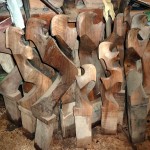 Let’s move now to another type of nautical woodcarving, one of a very specific and practical nature. The boats of the Venetian lagoon have long been powered by men who row while standing. They use very long oars called remo (singular) or remi (plural). The oars work against very special oarlocks called forcola (singular) or forcole (plural). A forcula is a carved piece that has several twists and curves. Every surface and notch can be used to lever a remo for a different movement. While most work is done with the remo in the very top notch, popping the remo up out of the small notch and dropping it down into the broad bend lets it work against that spot for reversing the direction of rowing. Watch a gondolier for a while and you’ll see many changes of position that help them maneuver their long boats in narrow canals.
Let’s move now to another type of nautical woodcarving, one of a very specific and practical nature. The boats of the Venetian lagoon have long been powered by men who row while standing. They use very long oars called remo (singular) or remi (plural). The oars work against very special oarlocks called forcola (singular) or forcole (plural). A forcula is a carved piece that has several twists and curves. Every surface and notch can be used to lever a remo for a different movement. While most work is done with the remo in the very top notch, popping the remo up out of the small notch and dropping it down into the broad bend lets it work against that spot for reversing the direction of rowing. Watch a gondolier for a while and you’ll see many changes of position that help them maneuver their long boats in narrow canals.
Remi and forcole are carved by highly skilled artisans. I don’t know how many of these people still exist, but two well known remers in Venice are Saverio Pastor and Paolo Brandolisio. Neither is bold enough to advertise the title, but those who examine the work of both men can easily call either of them Maestro Remer.
Here is a woodworking treat, a short clip of Paolo shaping a forcola for a gondola. Note also the wonderful vise. It stands all by itself, supported by a well in the shop floor.
More videos at Paolo’s YouTube channel. If these beautiful shapes have caught your interest, go see more at Saverio Pastor and Paolo Brandolisio web sites. Both have photo collections that show not only the objects but more of the process in making them, and photos of the workshops too.
Next, we’ll look at one more round of woodcarving examples, some real characters.
photo credits:
- Michelangelo crucifix – Wikipedia.org
- Bounty figurehead – Where_Is_Jo_Now
- Amistad figurehead – Gregory Moine
- small eagle stem head – ronniegrob
- Paolo’s forcole – La bottega di Paolo Brandolisio
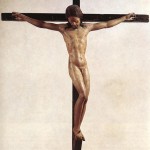
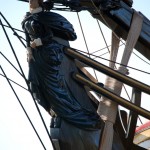
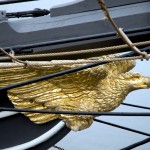
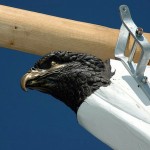
I love that vise!
Me too Shannon!
There are a couple of those vises in both Paolo’s and Saverio’s shops. One job is for holding forcole while carving. The other, of course is for holding remi … and how do you hold a 14-18 foot long remo (oar) in a vise? With a helper of course. See the neat tree-like helper in photo #7 in Paolo’s slideshow on this page. (click the photo to start a slideshow.) To understand what you are seeing in that photo, you are looking directly at the end of a remo which is clamped to the tree. The tree rests in a mortise in the top of a sawbench. The vise is mostly obscured, but is just like the one holding the forcula. The notches on the side of the tree provide resting spots for rotating the remo to work the edge and other surfaces. There’s another photo of both, #14.
When I carve rowing paddles on my traditional workbench, I long for one of these free standing vises and helper trees.